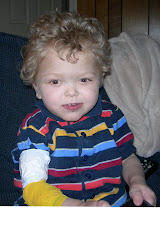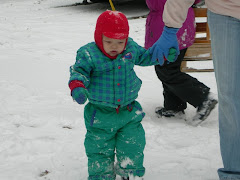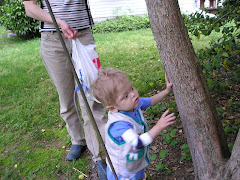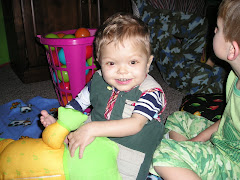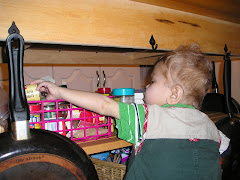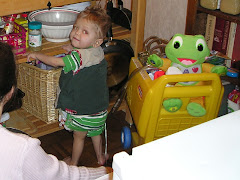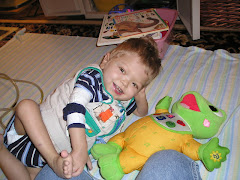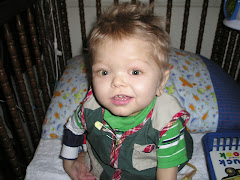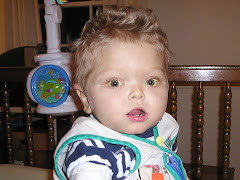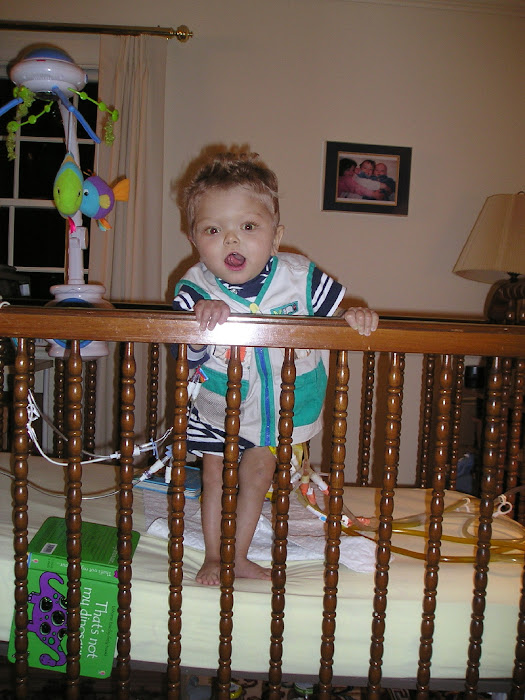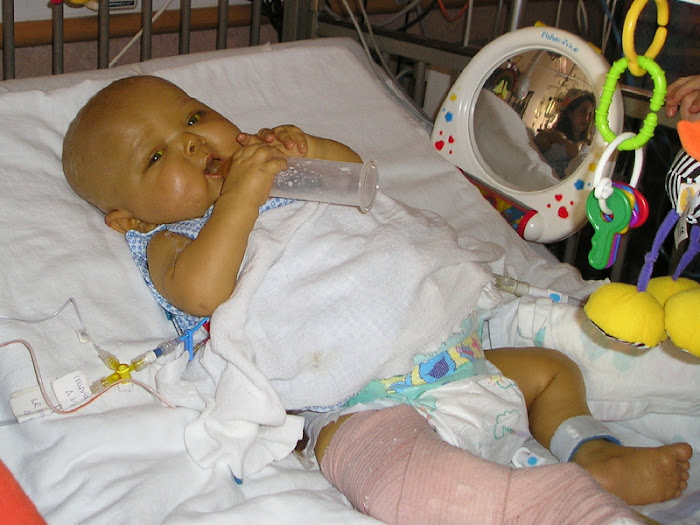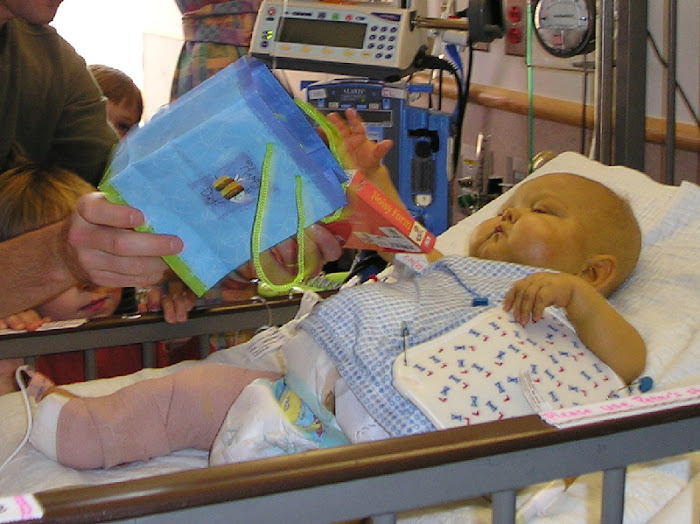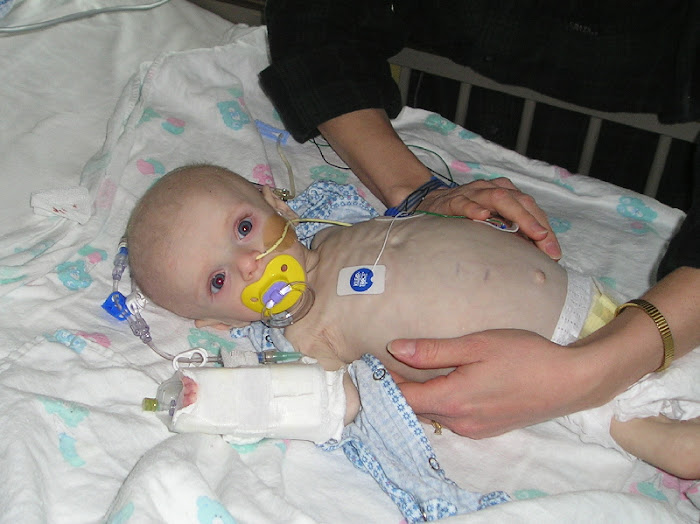Peter's recent CAIR appointment went as hoped. We met with Dr. Jennings and Dr. Kamin together and the topic of surgery for the fistula was revisited. Peter' fistula continues to put out 3/4 to a full liter of fluid a day. Dr. Kamin is rightfully concerned that we will end up back in the hospital for sodium issues if we are not careful, and that playing hospital at home is tricky and not without serious risk, so the feeds will remain at a standstill as to keep the fistula from continuing to rise in output. Dr. Jennings is in agreement then that we should revisit surgery if we are in such a tenuous place in the medical management of the fistula. Of course the same concerns about surgical risk exist as they did before, mainly centered around post-op recovery. Dr. Jennings came up with another idea as to how to close the fistula as he was examining Peter, which would be to close the skin over the fistula, as it seems that the drainage would continue to travel further down through the intestine if it were just not allowed to exit. If I understand correctly, he suspects that the intestine where the fistula is presses up against the abdominal wall, and that we could use the abdominal wall to close the fistula instead of actually trying to cut out the part of the intestine which contains Peter's very vascular fistula. This would greatly reduce the risk of bleeding since Peter has a huge collateral vein that connects to the fistula, and it would be a less complicated surgery by far. The downside is that there would be a good chance that the fistula would end up coming back at some point. The plan is to admit Peter for more abdominal examination which would involve scoping the fistula and a more thorough manual , evaluation of the fistula. Drs. Kamin and Jennings would team up together to evaluate and decide if this would potentially work. We are hoping for this to occur sometime soon in the new year.
Additionally, Peter continues to have small red spots on the left side of his chest, his left arm and hand are noticably bigger than the right, and the spider veins he has on his face seem to be more in number on the left than the right. The spots have been continuing to slowly develop over the last year, and there seems to be one now on his lower left eyelid margin. Dr. Kamin has suggested that we consult with the vascular clinic at Children's Boston, which is world-renowned. We have agreed that this sounds like a good idea and are waiting to hear from them as to what steps we need to take to investigate if this is a vascular abnormality or just a strange phenomenon for Peter whose medical progress doesn't follow the norm anyway.
Apparently the American Academy of Pediatrics has just come out with an officialy statement that probiotics should not be used in children with a central line, due to infection risk. Dr. Kamin brought that up as he felt it necessary that I know that, however he was also appreciative that Peter has been on probiotics for two years and has had no infection, so he is in agreement with our continuing to give Peter probiotics to keep intestinal bacterial overgrowth at bay.
We are also attempting to take Peter off Protonix. He has been on it for years, but there are risks to staying on proton-pump inhibitors, with one of the risks being to bone health. He does not show signs of needing to stay on it for reflux anymore, so we are starting a slow reduction and hopefully successful cessation of the medication.
Will post more about the plans for surgery and vascular clinic as we know more.
Friday, December 3, 2010
Friday, November 12, 2010
Running!
Peter's nurses, therapists, and family have put countless hours into Peter's physical therapy, and look at the results! He is having such a fun time running too!
An overdue update
I can't believe the last update was in July. Time has flown by! The biggest news is that Peter had his FIFTH birthday last week! It was wonderful, and our favorite part was his understanding and excitement about having a birthday. He had some healthy anticipation and did much of the planning for his big day, including making the decision that he would prefer to have his candles placed on a cake instead of the food he prefers to actually eat, which is mint-chocolate-chip ice-cream. He also wanted to go to Mass and to Longwood Gardens, which we gladly honored. Peter had a great time opening cards and gifts this year too, including one from the Coram team that prepares his TPN week after week after week!
The fistula output has returned with more volume than he had last Spring when we were talking about doing surgery to stop it. Putting on the huge amount of ascites is what likely slowed it down over the summer, but now that the ascites is back off, the output has gone up, even with less feeds than he had in the Spring. Peter has been on weekly labs for the last two months or more, as we try to keep electrolytes in balance. We are supposed to meet with the surgeon again when we go back up to Boston later this month, to see if we should revisit the idea of surgery. I don't know what else we can do besides surgery, as there seems to be no way to get Peter off TPN if we can't advance feeds due to the fistula output. The last discussion about surgery ended with a plan where he would be scheduled once he is off TPN for several months, but we can't even get enough in enterally to stop TPN for one night, let alone 7 nights a week. We can actually see and/or smell the enteral formula exiting the fistula, off and on most days.
Peter also has developed more red spots on his left upper chest and neck. We had noticed these towards the end of last year, and now there are more, but no one is sure what they are. His spider veins that are along his lower jawline seem to be more apparent now that his summer tan is going away. Hopefully they are not actually increasing.
Now back to more good news: Aside from the fistula going awry and the spots and spider veins, Peter is doing amazingly well. He is being reevaluated by his therapists to see if we can decrease his therapies now, from once a week to only once or twice a month instead. He is now truly interested in things like Playdoh and trucks and coloring, whereas a few months ago it took a good bit of encouragement to spark even some interest in doing those things.
He also took his first bathtub bath since he was about five or six months old. He screamed the whole time, and the next time too, but afterwards stated that he liked it and is agreeable to another bathtub bath next week. We have a PICC line protector which prevents water from getting to his PICC line and makes a bath feasible. It has taken a long time to convince him to wear it so he can get wet, and to be honest, it took me a long time to feel comfortable with trying a bath with Peter, as the risks of infection go up dramatically if the central line gets wet.
Peter is also learning to ride a bike with training wheels, he is learning to swing, and he has started taking interest in using his little outdoor tools to help his daddy when they are outside together. He is also running now, and he likes it too! To top things off, and remember, he has just turned five, he knows all of the states, by shape and location, and their capitals.
My favorite part of all of the changes though, is that Peter has become very outwardly affectionate with us. He comes up a couple times a day just to give a hug, or to say, "Oh, Mom!" and grab my hand for a loving squeeze. I smile even just as I am thinking about it!
The fistula output has returned with more volume than he had last Spring when we were talking about doing surgery to stop it. Putting on the huge amount of ascites is what likely slowed it down over the summer, but now that the ascites is back off, the output has gone up, even with less feeds than he had in the Spring. Peter has been on weekly labs for the last two months or more, as we try to keep electrolytes in balance. We are supposed to meet with the surgeon again when we go back up to Boston later this month, to see if we should revisit the idea of surgery. I don't know what else we can do besides surgery, as there seems to be no way to get Peter off TPN if we can't advance feeds due to the fistula output. The last discussion about surgery ended with a plan where he would be scheduled once he is off TPN for several months, but we can't even get enough in enterally to stop TPN for one night, let alone 7 nights a week. We can actually see and/or smell the enteral formula exiting the fistula, off and on most days.
Peter also has developed more red spots on his left upper chest and neck. We had noticed these towards the end of last year, and now there are more, but no one is sure what they are. His spider veins that are along his lower jawline seem to be more apparent now that his summer tan is going away. Hopefully they are not actually increasing.
Now back to more good news: Aside from the fistula going awry and the spots and spider veins, Peter is doing amazingly well. He is being reevaluated by his therapists to see if we can decrease his therapies now, from once a week to only once or twice a month instead. He is now truly interested in things like Playdoh and trucks and coloring, whereas a few months ago it took a good bit of encouragement to spark even some interest in doing those things.
He also took his first bathtub bath since he was about five or six months old. He screamed the whole time, and the next time too, but afterwards stated that he liked it and is agreeable to another bathtub bath next week. We have a PICC line protector which prevents water from getting to his PICC line and makes a bath feasible. It has taken a long time to convince him to wear it so he can get wet, and to be honest, it took me a long time to feel comfortable with trying a bath with Peter, as the risks of infection go up dramatically if the central line gets wet.
Peter is also learning to ride a bike with training wheels, he is learning to swing, and he has started taking interest in using his little outdoor tools to help his daddy when they are outside together. He is also running now, and he likes it too! To top things off, and remember, he has just turned five, he knows all of the states, by shape and location, and their capitals.
My favorite part of all of the changes though, is that Peter has become very outwardly affectionate with us. He comes up a couple times a day just to give a hug, or to say, "Oh, Mom!" and grab my hand for a loving squeeze. I smile even just as I am thinking about it!
Saturday, July 17, 2010
Some new photos, finally
Peter has had a love for violins for the last year or more.
Seeing a violin stops him dead in his tracks and he will then
declare that he sees one and insist that you also verify it is such.
We decided that it was time to go ahead and get him one.
Now we need to find a violin teacher!
This summer (2010) Peter has truly enjoyed the outdoors so
much more than he did last summer. His tolerance for
heat is vastly improved and he is able to spend long amounts of
time outside. His passion this summer is
blowing bubbles... over and over again.
He looks for shapes in what he has blown as well:
an Elmo head, Ten apples up on top, a bear claw...
This is Peter with his contagious grin. It was taken in January 2010,
when his ascites was at its absolute lowest.
With his ascites (intentionally) up very high right now,
his cheeks are very large and his face is overall puffier.
Puffy face or not,
that smile is as genuine as they come.
Thursday, July 15, 2010
Surgical plans postponed again
Sigh. It is hard to know what to hope for - surgery or no surgery. And, it is hard to know whether to be happy that the decision to postpone surgery was made based on the fact that Peter is doing so well.
For a child with short gut, Peter IS doing well. He is out of the hospital, labs are stable, his ostomy outputs are stable, he acts like he feels good, he is energetic, and we are able to advance his enteral feeds again. However, he is still on TPN 7 nights a week, has a central line to administer the TPN (he fights the dressing changes terribly and there are very big health risks if the site gets infected or wet), we have to drain his stomach every night or else he vomits, and he definitely is "different" from other children his age both in appearance and behavior... not to mention the lesser issues that come up in managing two ostomies.
The goal of surgery at this time was to stablilize his fistula outputs (but not necessarily close the fistula) and allow for us to increase his feeds and decrease his TPN dependence. Once off TPN, his liver will likely begin to heal and he should be able to tolerate bigger surgeries to close the ostomies. Now that he is accepting more feeds and the ostomies have been stable through it, it seems that he is accomplishing the surgical goal without the need for surgery.... at least for now. So we will take off some of the ascites, but not all of it in the event that the ascites is what made the fistula settle out somehow (maybe by pushing on the bowel and altering the flow). The hopes would be that we keep increasing feeds and outputs stay low and we get back to where we were before January 2010's admission. If we end up back where we were in January and can't control the fistula, then surgery looks like it will be imminently necessary.
If we keep outputs stable, then Dr. Jennings feels that the bowel closures (getting rid of the ileostomy and the fistula/jejunal ostomy) can be planned for age 7 or 8. Boy does that sound a long way off! He has seen pediatric patients settle themselves out and redirect their issues before. We have seen this in Peter ourselves too. The duodenostomy was very much out of control about two years ago and then it just suddenly started closing off to a few milliliters out per day. Perhaps this is what Peter is doing with the fistula now. Only time and advancement of feeds again will help us know this.
Of note, the abdominal ultrasound today shows that the bowel is not adhered to the abdominal wall as was feared. That is good news for surgery whenever it occurs.
AND, we are going to try the Farrell bag by Corpak that Susan in Canada told me about in the comments on the last post. Hopefully that will help us to feed Peter and vent him overnight using the gastrostomy that he has. We've not been able to successfully feed him more than 15 mL ovenight since the ascites was put on, due to the need to vent instead. It looks like a great product.
For a child with short gut, Peter IS doing well. He is out of the hospital, labs are stable, his ostomy outputs are stable, he acts like he feels good, he is energetic, and we are able to advance his enteral feeds again. However, he is still on TPN 7 nights a week, has a central line to administer the TPN (he fights the dressing changes terribly and there are very big health risks if the site gets infected or wet), we have to drain his stomach every night or else he vomits, and he definitely is "different" from other children his age both in appearance and behavior... not to mention the lesser issues that come up in managing two ostomies.
The goal of surgery at this time was to stablilize his fistula outputs (but not necessarily close the fistula) and allow for us to increase his feeds and decrease his TPN dependence. Once off TPN, his liver will likely begin to heal and he should be able to tolerate bigger surgeries to close the ostomies. Now that he is accepting more feeds and the ostomies have been stable through it, it seems that he is accomplishing the surgical goal without the need for surgery.... at least for now. So we will take off some of the ascites, but not all of it in the event that the ascites is what made the fistula settle out somehow (maybe by pushing on the bowel and altering the flow). The hopes would be that we keep increasing feeds and outputs stay low and we get back to where we were before January 2010's admission. If we end up back where we were in January and can't control the fistula, then surgery looks like it will be imminently necessary.
If we keep outputs stable, then Dr. Jennings feels that the bowel closures (getting rid of the ileostomy and the fistula/jejunal ostomy) can be planned for age 7 or 8. Boy does that sound a long way off! He has seen pediatric patients settle themselves out and redirect their issues before. We have seen this in Peter ourselves too. The duodenostomy was very much out of control about two years ago and then it just suddenly started closing off to a few milliliters out per day. Perhaps this is what Peter is doing with the fistula now. Only time and advancement of feeds again will help us know this.
Of note, the abdominal ultrasound today shows that the bowel is not adhered to the abdominal wall as was feared. That is good news for surgery whenever it occurs.
AND, we are going to try the Farrell bag by Corpak that Susan in Canada told me about in the comments on the last post. Hopefully that will help us to feed Peter and vent him overnight using the gastrostomy that he has. We've not been able to successfully feed him more than 15 mL ovenight since the ascites was put on, due to the need to vent instead. It looks like a great product.
Thursday, July 1, 2010
Big belly, plans to unfold
Peter hit his ascites goal weeks ago. We have been maintaining an abdominal circumference of 67 to 68cm, occasionally hitting 69cm. He is four and a half years old, and had been wearing size 5 overalls to accomodate his belly, prior to trying to increase his girth. He is now in a size 7/8 overalls due to the increase in his belly. He is still unable to be fed overnight, and needs to be vented through his G tube instead. His face is still puffy with the extra fluid. His hydroceles repair has withheld through all of this extra fluid, but he does appear to have two bilateral areas of swelling above the scrotum now, seen when he exerts. It will be good when we can stop needing him to hold onto his ascites.
The plan to do surgery is still uncertain. We are going up to Boston soon and will meet with Dr. Jennings, Dr. Kim, and Dr. Kamin to discuss exactly what to do. We are set up for surgery in late July if the best plan seems like it is surgery. Before that talk, we will have an abdominal ultrasound to assess where the ascites is accumulating in the belly. Hopefully the abdomial fluid is causing expansion in a way the the surgeon feels is helpful.
To add some confusion to the overall picture, Peter's fistula output has gone down since the ascites has gone up. To help understand this, we have now started trying to increase daytime feeds again to see if the fistula output goes up as we increase feeds. If the output does not go up much as we increase feeds, then it may cause the doctors to ponder whether surgery is necessary at this time. Recall that the increase in fistula output was the cause for the consideration of surgery at this time. I am guessing though, that if we lowered Peter's ascites again, the fistula would pick up again. What I mentally picture is a pocket of fluid that pushes on the intestines in a way that pinches off the fistula opening so that only a little fluid comes out, and when his ascites is less the opening opens up further. The docs seem to picture that possibility too, but we have not captured that in imaging tests, so it is hard to know. It could also be that Peter had some kind of GI bug that threw his gut out of whack back in December/January, and that with the reduced feeds and with time, it settled out and that is the cause for the fistula output going down. Hopefully we will get to advance the feeds enough before we go up to Boston, that we can see if the change in feeds affects the fistula. We are hoping that the surgery can happen during the summer when the cold and flu virsus levels are low. If we have to return home again and wait further to see how the fistula performs with addition of more feeds and reduction of ascites again, it looks like we will not have that summer advantage, and there will be more waiting as we watch to see how feeds and fistula output go.
We count our blessings that Peter is the pleasant, happy child that he is. It is hard for us to be patient with all of the uncertainty sometimes. In his sweet little ways he gets us through those times and reminds us to enjoy the time we have now. We went blueberry picking today and it was just great! (Of course, I left the camera at home though.... again.)
The plan to do surgery is still uncertain. We are going up to Boston soon and will meet with Dr. Jennings, Dr. Kim, and Dr. Kamin to discuss exactly what to do. We are set up for surgery in late July if the best plan seems like it is surgery. Before that talk, we will have an abdominal ultrasound to assess where the ascites is accumulating in the belly. Hopefully the abdomial fluid is causing expansion in a way the the surgeon feels is helpful.
To add some confusion to the overall picture, Peter's fistula output has gone down since the ascites has gone up. To help understand this, we have now started trying to increase daytime feeds again to see if the fistula output goes up as we increase feeds. If the output does not go up much as we increase feeds, then it may cause the doctors to ponder whether surgery is necessary at this time. Recall that the increase in fistula output was the cause for the consideration of surgery at this time. I am guessing though, that if we lowered Peter's ascites again, the fistula would pick up again. What I mentally picture is a pocket of fluid that pushes on the intestines in a way that pinches off the fistula opening so that only a little fluid comes out, and when his ascites is less the opening opens up further. The docs seem to picture that possibility too, but we have not captured that in imaging tests, so it is hard to know. It could also be that Peter had some kind of GI bug that threw his gut out of whack back in December/January, and that with the reduced feeds and with time, it settled out and that is the cause for the fistula output going down. Hopefully we will get to advance the feeds enough before we go up to Boston, that we can see if the change in feeds affects the fistula. We are hoping that the surgery can happen during the summer when the cold and flu virsus levels are low. If we have to return home again and wait further to see how the fistula performs with addition of more feeds and reduction of ascites again, it looks like we will not have that summer advantage, and there will be more waiting as we watch to see how feeds and fistula output go.
We count our blessings that Peter is the pleasant, happy child that he is. It is hard for us to be patient with all of the uncertainty sometimes. In his sweet little ways he gets us through those times and reminds us to enjoy the time we have now. We went blueberry picking today and it was just great! (Of course, I left the camera at home though.... again.)
Friday, May 28, 2010
The Alternate Bowel Plan
We discussed this plan initially while up in Boston, but I haven't posted about it because no one was sure if this was the approach we would take. The plan is to create more ascites in Peter's belly to prepare him for one of the abdominal surgeries that I described in the last post. Ascites is basically fluid accumulation in the abdomen, and it can make the abdomen protrude quite far. Usually we are trying to keep ascites off Peter. He is quite prone it, but by monitoring and adjusting sodium and fluid, we can keep it in check.
We are now trying to take advantage of his tendency to putting on weight in the belly so that there is extra abdominal skin when he goes for surgery. One of the many surgical challenges that Peter faces is the possibility of not being able to close the abdomen back up after surgery. Peter was unable to be surgically closed after he suffered from abdominal compartment syndrome back with his initial surgeries. His little body spent months growing skin over a mesh dressing that was placed over his intestines. That area is now a patch of scar tissue roughly three inches by five inches, and the muscles underneath are still about 4 cm apart, where they should actually be touching. The big issue with leaving the abdomen open like he had to, is primarily infection. That is a huge risk, especially when there is an ileostomy present as well. The development of a fistula is another issue, as we found out when Peter developed a fistula right in the middle of the scar tissue, where a little piece of mesh was poking out. If we can expand his abdomen enough now, then he should stand a better chance of post-operative closure.
It is a novel idea to do this using ascites, apparently. The development of full-blown ascites carries risks such as difficulty breathing, general discomfort in the abdomen, and infection of the ascites fluid itself. However, Peter has had more and less ascites all along, and generally he seems to weather it well. We are all watching him carefully as we begin trying to expand his belly now. He started at 61cm around about three weeks ago and he is now 64cm around.
It is hard to watch him get bigger in the gut and not want to take that fluid back off him. He will likely look more and more puffy in the face as this continues, and I imagine he will end up wearing nothing more than big T-shirts and his diaper, instead of his cute little overalls that cover up his ostomies and slightly big belly usually. But, as it has the potential to provide a big advantage to his surgical recovery... please pass the salt!
We are now trying to take advantage of his tendency to putting on weight in the belly so that there is extra abdominal skin when he goes for surgery. One of the many surgical challenges that Peter faces is the possibility of not being able to close the abdomen back up after surgery. Peter was unable to be surgically closed after he suffered from abdominal compartment syndrome back with his initial surgeries. His little body spent months growing skin over a mesh dressing that was placed over his intestines. That area is now a patch of scar tissue roughly three inches by five inches, and the muscles underneath are still about 4 cm apart, where they should actually be touching. The big issue with leaving the abdomen open like he had to, is primarily infection. That is a huge risk, especially when there is an ileostomy present as well. The development of a fistula is another issue, as we found out when Peter developed a fistula right in the middle of the scar tissue, where a little piece of mesh was poking out. If we can expand his abdomen enough now, then he should stand a better chance of post-operative closure.
It is a novel idea to do this using ascites, apparently. The development of full-blown ascites carries risks such as difficulty breathing, general discomfort in the abdomen, and infection of the ascites fluid itself. However, Peter has had more and less ascites all along, and generally he seems to weather it well. We are all watching him carefully as we begin trying to expand his belly now. He started at 61cm around about three weeks ago and he is now 64cm around.
It is hard to watch him get bigger in the gut and not want to take that fluid back off him. He will likely look more and more puffy in the face as this continues, and I imagine he will end up wearing nothing more than big T-shirts and his diaper, instead of his cute little overalls that cover up his ostomies and slightly big belly usually. But, as it has the potential to provide a big advantage to his surgical recovery... please pass the salt!
Wednesday, May 5, 2010
Surgical plans changed
Dr. Jennings met with us today. Peter was scheduled for surgery tomorrow - a shunt procedure to decrease portal hypertension so that we could proceed with bowel closure several weeks later. That surgery is now cancelled, as a decision made together with him and us. The concerns with the shunt are that the liver may not receive enough blood for good perfusion, and that the liver may be taxed too hard with such a major surgery at this time. Peter's biopsy last month shows that Peter's liver disease has not progressed, but that he still has some bridging fibrosis. That makes his liver more vulnerable in recovery from major surgery.
Our plans now are going to involve a different surgical approach in a few months. Dr. Jennings will likely try to attach the lower section of bowel to Peter's stomach so that food can pass through the bowel and less come out the fistula. Or he may try to close the fistula, but the fistula has huge collateral blood flow and tying off the circulation may increase portal hypertension, adversely affecting the liver. (Hence one of the reasons we had been planning for a shunt procedure in the first place.) Both surgical approaches are on the drawing board at the moment, with a leaning towards the first approach.
The thought is that if we can utilize the bowel enough to get off TPN, the liver has a good chance of healing. Then the bigger surgeries required to finish rerouting the collateral circulation and closing the fistula may be performed at some point later on if possible. If the bowel closures cannot be performed, even if we can just get Peter off TPN it would ultimately help his liver and be better for him.
None of this is an easy solution, and plans of course may detour again, but we are all optimistic that this is all in Peter's best interest. We were again reminded by Dr. Jennnings that there is no other person in the world like Peter. Between the bowel, the liver, the portal vein clot... he is quite unique. The fact that he is not only alive, but is alive and thriving, is truly remarkable. Omegaven saved his liver and has undoubtedly extended his life on TPN. Without Omegaven he would have either needed to go on for transplant or would have died.
So, as plans for a different surgery unfold, more will be posted. For now, we will return home tomorrow and hopefully get around to posing some of the photos that are long overdue on this site.
Our plans now are going to involve a different surgical approach in a few months. Dr. Jennings will likely try to attach the lower section of bowel to Peter's stomach so that food can pass through the bowel and less come out the fistula. Or he may try to close the fistula, but the fistula has huge collateral blood flow and tying off the circulation may increase portal hypertension, adversely affecting the liver. (Hence one of the reasons we had been planning for a shunt procedure in the first place.) Both surgical approaches are on the drawing board at the moment, with a leaning towards the first approach.
The thought is that if we can utilize the bowel enough to get off TPN, the liver has a good chance of healing. Then the bigger surgeries required to finish rerouting the collateral circulation and closing the fistula may be performed at some point later on if possible. If the bowel closures cannot be performed, even if we can just get Peter off TPN it would ultimately help his liver and be better for him.
None of this is an easy solution, and plans of course may detour again, but we are all optimistic that this is all in Peter's best interest. We were again reminded by Dr. Jennnings that there is no other person in the world like Peter. Between the bowel, the liver, the portal vein clot... he is quite unique. The fact that he is not only alive, but is alive and thriving, is truly remarkable. Omegaven saved his liver and has undoubtedly extended his life on TPN. Without Omegaven he would have either needed to go on for transplant or would have died.
So, as plans for a different surgery unfold, more will be posted. For now, we will return home tomorrow and hopefully get around to posing some of the photos that are long overdue on this site.
Monday, April 19, 2010
March and April
Lots of "boring" news, but the really exciting stuff will be coming soon when we go to Boston for SURGERY! Peter went up to Children's Boston last week for a liver biopsy and CT to help plan for abdominal surgery. The fistula continues to put out more and more amounts, requiring continued weekly electrolyte labs, often followed by yet another tweaking of his TPN (IV nutrition) recipe to keep on top of the electrolyte changes produced by the fistula outputs. Dr. Jennings, one of the surgeons at Children's, met with us when we went up in March, and it seems like surgery is the best solution for Peter at this point. It has been a long hope to reconnect the bowel, but for Peter a reconnection is not so simple. The first thing that will need to be done is the placement of a shunt which will bypass the clot in the portal vein, thereby decreasing the portal hypertension that Peter has in his abdomen. That will then assist the gut in its circulation and overall health and ability to digest food, as well as decrease the tendency to bleed as much during surgery. I don't yet know the plan from there, but discussions have included surgery to close the fistula as well; I am not sure of the timing on that yet.
The PICC line dressing was solved with another style of statlock that I found online. It has a deeper, wider indent at the top, which allows for more clearance room between the insertion site and the statlock. With that, we decrease the risk of contamination of the PICC site, as the statlock does not rub up near the insertion. If I get a chance to take and download a photo I will. (The photo below is from an earlier post and it has the old statlock shown.) The new statlock style, if anyone is looking at this and wanting to try it to resolve a similar situation, is PIC0220, made by Bard. The other thing we did to make the dressing change less subject to contamination, was to add another set of sterile gloves to our dressing change, so that the line is kept as clean as possible. I don one pair of sterile gloves during the removal of the old statlock, after removing the tegaderm with nonsterile gloves. Then I put on a new pair of sterile gloves to clean the line and put on the new statlock. We use a third pair on my husband who holds the catheter in place at the insertion site as the old dressing is being removed and I am changing gloves, but before it is cleaned with chloraprep, as Peter is still prone to wanting to move around whether the PICC line is secure or not.
On a non-medical front, Peter is very close to running now! He runs like a toddler at this point. It is more than a brisk walk, but not quite the run that a 3 or 4 year old would use. The look on his face as he runs is priceless. He is very pleased with himself and his "great speed." The cheers that his family and nurse give him certainly add to his satisfied self-image... as it should be.
I am having technical problems adding photos tonight, but hopefully can download his running video soon, as well as some new photos of Mr. Peter.
The PICC line dressing was solved with another style of statlock that I found online. It has a deeper, wider indent at the top, which allows for more clearance room between the insertion site and the statlock. With that, we decrease the risk of contamination of the PICC site, as the statlock does not rub up near the insertion. If I get a chance to take and download a photo I will. (The photo below is from an earlier post and it has the old statlock shown.) The new statlock style, if anyone is looking at this and wanting to try it to resolve a similar situation, is PIC0220, made by Bard. The other thing we did to make the dressing change less subject to contamination, was to add another set of sterile gloves to our dressing change, so that the line is kept as clean as possible. I don one pair of sterile gloves during the removal of the old statlock, after removing the tegaderm with nonsterile gloves. Then I put on a new pair of sterile gloves to clean the line and put on the new statlock. We use a third pair on my husband who holds the catheter in place at the insertion site as the old dressing is being removed and I am changing gloves, but before it is cleaned with chloraprep, as Peter is still prone to wanting to move around whether the PICC line is secure or not.
On a non-medical front, Peter is very close to running now! He runs like a toddler at this point. It is more than a brisk walk, but not quite the run that a 3 or 4 year old would use. The look on his face as he runs is priceless. He is very pleased with himself and his "great speed." The cheers that his family and nurse give him certainly add to his satisfied self-image... as it should be.
I am having technical problems adding photos tonight, but hopefully can download his running video soon, as well as some new photos of Mr. Peter.
Monday, March 1, 2010
We don't like the new PICC afterall
There, it's official. We do not like the new PICC that Peter got in January. I do like a PICC line in general, but not this new one. The biggest frustration with it is the placement. This may be a very boring entry for anyone who does not have a PICC line, but for someone familiar with PICCs, perhaps it will be of interest. I do need to vent this frustration, so I am posting it.
For the last three years, Peter's PICC lines were secured with a little adhesive device called a Stat-Lock, which was located about an inch below the actual insetion site of the PICC line. It was a good set-up, as the Stat-Lock was capable of lasting up to a month and did not need to be kept sterile since it was so far away from the insertion site of the PICC.
The new line has the Stat-Lock actually just one or two millimeters from the insertion site, surrounding the site itself, and now needs to be changed every week with the dressing change. The Stat-Lock device has these little "doors" that keep the PICC line from popping back off the device, and these tiny movable posts on which the PICC cross post need to be landed. Somehow this is all to be kept sterile as we are opening and closing the little doors to remove the old Stat-Lock, and then opening and closing little doors as we put on the new Stat-Lock. It can be done on a mannekin arm or on an adult that stays still, but on a four-year-old child, it gets a little tricky, even with another adult immobilizing the arm and Peter's body. To remove the old Stat-Lock, we need to lift up the PICC line, which then tries to work its way out of Peter's arm while we frantically work on keeping it from sliding out, sterile gloves becoming dangerously close to non-sterile, if not truly non-sterile despite our best efforts. It is like trying to manipulate a wet noodle as it wants to slide out and we are trying to push on it to stay in. Once the entire site is cleaned, we can put the PICC line down and hold it more securely, but then we have to lift the PICC line again to place the new Stat-Lock on... trying to be sterile, landing it just a millimeter or two away from the sterile insertion site, wet noodle thing happening again.
The whole procedure is ridiculous in light of the set-up we used to have. We have had so many people remark on how well we maintained his old site and how remarkable it was that he didn't get PICC line infections. With this new line sliding in and out during dressing changes and with the Stat-Lock so close to the insertion site, I will be the one amazed if we are able to keep Peter's line infection free, or from just sliding on out during one of our dressing changes. We are hearing from some of Peter's nurses that this is the current procedure for PICC lines, with the Stat-Lock where our new one is. I will not be surprised to see that the rate of infection also rises with this current trend.
For the last three years, Peter's PICC lines were secured with a little adhesive device called a Stat-Lock, which was located about an inch below the actual insetion site of the PICC line. It was a good set-up, as the Stat-Lock was capable of lasting up to a month and did not need to be kept sterile since it was so far away from the insertion site of the PICC.
The new line has the Stat-Lock actually just one or two millimeters from the insertion site, surrounding the site itself, and now needs to be changed every week with the dressing change. The Stat-Lock device has these little "doors" that keep the PICC line from popping back off the device, and these tiny movable posts on which the PICC cross post need to be landed. Somehow this is all to be kept sterile as we are opening and closing the little doors to remove the old Stat-Lock, and then opening and closing little doors as we put on the new Stat-Lock. It can be done on a mannekin arm or on an adult that stays still, but on a four-year-old child, it gets a little tricky, even with another adult immobilizing the arm and Peter's body. To remove the old Stat-Lock, we need to lift up the PICC line, which then tries to work its way out of Peter's arm while we frantically work on keeping it from sliding out, sterile gloves becoming dangerously close to non-sterile, if not truly non-sterile despite our best efforts. It is like trying to manipulate a wet noodle as it wants to slide out and we are trying to push on it to stay in. Once the entire site is cleaned, we can put the PICC line down and hold it more securely, but then we have to lift the PICC line again to place the new Stat-Lock on... trying to be sterile, landing it just a millimeter or two away from the sterile insertion site, wet noodle thing happening again.
The whole procedure is ridiculous in light of the set-up we used to have. We have had so many people remark on how well we maintained his old site and how remarkable it was that he didn't get PICC line infections. With this new line sliding in and out during dressing changes and with the Stat-Lock so close to the insertion site, I will be the one amazed if we are able to keep Peter's line infection free, or from just sliding on out during one of our dressing changes. We are hearing from some of Peter's nurses that this is the current procedure for PICC lines, with the Stat-Lock where our new one is. I will not be surprised to see that the rate of infection also rises with this current trend.
Thursday, February 25, 2010
GI plans
It looks like we will plan to do a fluoroscopy study late next month to find out what is going on inside Peter's GI tract. The fistula continues to put out more fluid than it used to, even with the feeds less than half of what they had been when we went up to Boston last time.
A fluoroscopy study on Peter is never easy because he has several places where the contrast fluid leaks out after it is put into his G-tube. The leakage of fluid into his dressing and into his ostomy bags then makes it impossible to see what is going on inside. I am not sure how we are going to work this out, but hope if it involves the removal of ostomy bags during the procedure that we are able to keep the PICC line clean!! We've managed it before, and with many prayers will hopefully manage to keep the line clean again. Dr. Kamin and Dr. Jennings will be there for the one to two hour procedure, and possibly Dr. Kim as well. Dr. Jennings and Dr. Kim are the surgeons who are familiar with Peter's anatomy.
Peter is still on TPN 7 nights a week, as we can't advance his feeds to where they had been before. We are managing to keep his sodium levels stable though, only needing to add a little 1/2 normal saline here and there when his outputs exceed his new baseline.
Please keep Peter in your prayers as we sort out his fistula issues. We are praying for test results that show us that it is time to close the fistula, as well as the doctors finding that it would not be as difficult to surgically close as feared.
A fluoroscopy study on Peter is never easy because he has several places where the contrast fluid leaks out after it is put into his G-tube. The leakage of fluid into his dressing and into his ostomy bags then makes it impossible to see what is going on inside. I am not sure how we are going to work this out, but hope if it involves the removal of ostomy bags during the procedure that we are able to keep the PICC line clean!! We've managed it before, and with many prayers will hopefully manage to keep the line clean again. Dr. Kamin and Dr. Jennings will be there for the one to two hour procedure, and possibly Dr. Kim as well. Dr. Jennings and Dr. Kim are the surgeons who are familiar with Peter's anatomy.
Peter is still on TPN 7 nights a week, as we can't advance his feeds to where they had been before. We are managing to keep his sodium levels stable though, only needing to add a little 1/2 normal saline here and there when his outputs exceed his new baseline.
Please keep Peter in your prayers as we sort out his fistula issues. We are praying for test results that show us that it is time to close the fistula, as well as the doctors finding that it would not be as difficult to surgically close as feared.
Monday, January 25, 2010
An unexpected admission
Peter's CAIR appointment went well, but what we weren't counting on was an admission! Peter's blood sodium was at a value considered critically low, so he was admitted for correction of that low sodium. Apparently correcting hyponatremia (low blood sodium) too rapidly can lead to swelling of the brain, so there needs to be a gradual increase back to normal value, done in an ICU setting, at least until the level is high enough to require less labs and less monitoring.
Peter had been acting well, so the low sodium was a surprise to EVERYONE. The only real change in him has been a fairly high increase in fistula output over the past few weeks, continuing even after we changed to Elecare again (discussed in the last post). Peter dropped two and a half pounds over the last month, some of it is likely true weight loss since we had decreased formula concentration and amount without going up in TPN. More of the loss, though, seems to be the ascites that has disappeared over the last several weeks as the fistula output went up. The fistula output seems to have a high amount of sodium, and that has undoubtedly been the main cause of his low serum sodium.
There are a few reasons that the fistula could be putting out more, but to diagnose the cause with certainty would involve radiation to image the bowel. The prudent thing then is to do some trial and error with feeds and labs to monitor the sodium. If that doesn't work, then we will need to do further testing.
The trick is to prevent another bout of this hyponatremia. As such, the plan now is to go on TPN seven nights a week again, unfortunately. The reason for adding back all three nights off of TPN is because we have had to drastically cut back on feeds in an attempt to get the fistula to slow back down. He is getting just 10 mL an hour of formula now, whereas he had been up to 850 plus of formula a day. The hope is to slowly advance each week and to keep the fistula output from advancing with the formula increase.
The plan also is to keep the ascites off Peter's abdomen now that it is gone. He has had ascites even before the AVM was found. It is one of the symptoms that you often see with liver disease. With ascites, there is too much fluid in the body's abdominal tissue, and sodium affects that. For Peter, "too much sodium" is actually what would be a normal value for most people. When we see his belly get larger, we can tell without labs that his sodium levels are rising. It will be tricky to get his sodium leveled out without his ascites returning. It is so good to see his body without the giant abdomen that he has had for so long, and we all feel it is best for him to keep it from returning... if we can.
I have to say that if ever there was a "better" time for this to have happened, it was during this trip. We had already planned to spend the night in Boston, so we did not have to turn around and drive several hours back. As much as it is stressful going to the ER at 9:30 at night with a four year old who is hooked up to TPN and another IV pump that is the size of a double toaster, and an enteral feeding pump, along with an infant, it would have been so much worse had we needed to drive several hours back or needed to go to some other nearby ER that didn't know him at all. Dr. Kamin graciously called in to make sure that things went smoothly and that all parties involved were following the same plan for Peter. Even on vacation he called in to make sure all was going well. Thank you, Dr. Kamin!
Something of interest to add, is that during our ER trip, we encountered a Fellow who had taken care of Peter when she was a Resident at CHOP. She was just as surprised to see Peter as we were to see her. She remembers when he was at CHOP early on when the AVM had not yet been found, as well as when he was in the ICU at CHOP having bleeds requiring emergency transfusions. And she recalled that we left for Boston from CHOP's ICU to Boston's ICU so that we could get Peter on Omegaven. Now he is four years old, talking, eating, and one happy kid. We emphasized that Omegaven was the medication that helped him be able to get to this point, and that having one physician continually oversee him versus rotating doctors, also got him to this point. Hopefully she will remember these things as she goes on in medicine, and maybe they will be helpful to someone she cares for down the line.
One last thing.... Peter got his new PICC. It is a beauty as far as PICCs go, a little more bulky with the clamp, but it is a single lumen this time, so less bulk overall. Let's hope this one lasts a very long time. It works, so we are off to a better start than with the last PICC.
Peter had been acting well, so the low sodium was a surprise to EVERYONE. The only real change in him has been a fairly high increase in fistula output over the past few weeks, continuing even after we changed to Elecare again (discussed in the last post). Peter dropped two and a half pounds over the last month, some of it is likely true weight loss since we had decreased formula concentration and amount without going up in TPN. More of the loss, though, seems to be the ascites that has disappeared over the last several weeks as the fistula output went up. The fistula output seems to have a high amount of sodium, and that has undoubtedly been the main cause of his low serum sodium.
There are a few reasons that the fistula could be putting out more, but to diagnose the cause with certainty would involve radiation to image the bowel. The prudent thing then is to do some trial and error with feeds and labs to monitor the sodium. If that doesn't work, then we will need to do further testing.
The trick is to prevent another bout of this hyponatremia. As such, the plan now is to go on TPN seven nights a week again, unfortunately. The reason for adding back all three nights off of TPN is because we have had to drastically cut back on feeds in an attempt to get the fistula to slow back down. He is getting just 10 mL an hour of formula now, whereas he had been up to 850 plus of formula a day. The hope is to slowly advance each week and to keep the fistula output from advancing with the formula increase.
The plan also is to keep the ascites off Peter's abdomen now that it is gone. He has had ascites even before the AVM was found. It is one of the symptoms that you often see with liver disease. With ascites, there is too much fluid in the body's abdominal tissue, and sodium affects that. For Peter, "too much sodium" is actually what would be a normal value for most people. When we see his belly get larger, we can tell without labs that his sodium levels are rising. It will be tricky to get his sodium leveled out without his ascites returning. It is so good to see his body without the giant abdomen that he has had for so long, and we all feel it is best for him to keep it from returning... if we can.
I have to say that if ever there was a "better" time for this to have happened, it was during this trip. We had already planned to spend the night in Boston, so we did not have to turn around and drive several hours back. As much as it is stressful going to the ER at 9:30 at night with a four year old who is hooked up to TPN and another IV pump that is the size of a double toaster, and an enteral feeding pump, along with an infant, it would have been so much worse had we needed to drive several hours back or needed to go to some other nearby ER that didn't know him at all. Dr. Kamin graciously called in to make sure that things went smoothly and that all parties involved were following the same plan for Peter. Even on vacation he called in to make sure all was going well. Thank you, Dr. Kamin!
Something of interest to add, is that during our ER trip, we encountered a Fellow who had taken care of Peter when she was a Resident at CHOP. She was just as surprised to see Peter as we were to see her. She remembers when he was at CHOP early on when the AVM had not yet been found, as well as when he was in the ICU at CHOP having bleeds requiring emergency transfusions. And she recalled that we left for Boston from CHOP's ICU to Boston's ICU so that we could get Peter on Omegaven. Now he is four years old, talking, eating, and one happy kid. We emphasized that Omegaven was the medication that helped him be able to get to this point, and that having one physician continually oversee him versus rotating doctors, also got him to this point. Hopefully she will remember these things as she goes on in medicine, and maybe they will be helpful to someone she cares for down the line.
One last thing.... Peter got his new PICC. It is a beauty as far as PICCs go, a little more bulky with the clamp, but it is a single lumen this time, so less bulk overall. Let's hope this one lasts a very long time. It works, so we are off to a better start than with the last PICC.
Saturday, January 9, 2010
Increased outputs and formula changes
We are back to Elecare from Vital Jr in effort to see if Peter is having some intolerance to Vital Jr. Peter's fistula and ileostomy outputs have drifted up over the last couple of months, and he has had 3 bouts of really high outputs with 2 needing him to go on Pedialyte for 2 or 4 days until it settled out. We were emptying his fistula bag every 1 to 2 hours at some points!
The other questions as to why his outputs have gone up so dramatically would be whether he is having bacterial overgrowth (SBBO)or if this is an anatomical change. We see that the fistula's output is consistently higher than the ileostomy over the last few months, but that did not occur anywhere near the timing of the gastrostomy repair which ended the stomach losses. Peter doesn't display his SBBO symptoms from the past though, so hard to say it is that. We did withhold his probiotics for two separate weeks in December, so it could be overgrowth. We are adding kefir and daily plain Stonyfield yogurt to his diet to assist with the usual probiotics in the event that he needs an extra boost of probiotic. Peter's history of reactions to enteral antibiotics for SBBO keeps us all hesitant to treat him empirically with a round or two of antibiotics. If anyone wants to know what he uses, we are still on VSL#3 and florastor, rotating one week on one and one week on the other, usually without a break between.
The good news seems to be that with the caloric decline that occurred by going back on 26 calorie Elecare from 30 calorie Vital Jr and by decreasing the volume from 950 to 650 per day, is that Peter is HUNGRY! He is remarkably interested in nibbling on crackers now, and as such is working on his feeding skills without prompting. And, although he has lost about two pounds with the diarrhea and with the reduction in calories, his new-found hunger may be showing us that his gut has been working well absorbing Vital Jr all along, despite the increased outputs.
Because he has lost weight, is showing us that he is hungry, and is continuing to slow down with his fistula output, we are going up in Elecare volume over the next few days. Hopefully he will regain the weight and keep the fistula output down. We will reassess where he is when back up in Boston.
The other questions as to why his outputs have gone up so dramatically would be whether he is having bacterial overgrowth (SBBO)or if this is an anatomical change. We see that the fistula's output is consistently higher than the ileostomy over the last few months, but that did not occur anywhere near the timing of the gastrostomy repair which ended the stomach losses. Peter doesn't display his SBBO symptoms from the past though, so hard to say it is that. We did withhold his probiotics for two separate weeks in December, so it could be overgrowth. We are adding kefir and daily plain Stonyfield yogurt to his diet to assist with the usual probiotics in the event that he needs an extra boost of probiotic. Peter's history of reactions to enteral antibiotics for SBBO keeps us all hesitant to treat him empirically with a round or two of antibiotics. If anyone wants to know what he uses, we are still on VSL#3 and florastor, rotating one week on one and one week on the other, usually without a break between.
The good news seems to be that with the caloric decline that occurred by going back on 26 calorie Elecare from 30 calorie Vital Jr and by decreasing the volume from 950 to 650 per day, is that Peter is HUNGRY! He is remarkably interested in nibbling on crackers now, and as such is working on his feeding skills without prompting. And, although he has lost about two pounds with the diarrhea and with the reduction in calories, his new-found hunger may be showing us that his gut has been working well absorbing Vital Jr all along, despite the increased outputs.
Because he has lost weight, is showing us that he is hungry, and is continuing to slow down with his fistula output, we are going up in Elecare volume over the next few days. Hopefully he will regain the weight and keep the fistula output down. We will reassess where he is when back up in Boston.
Monday, January 4, 2010
Peter's new PICC
The week before Christmas Peter needed to have his monthly labs drawn from his PICC line. Routine labs, routine procedure. Not this time. This time the PICC would not give more than 2mL of blood for labs and we needed about 20mL. So after some talks with the homecare nursing team and Children's Boston, we agreed that Peter's line could be tPA'd in the home setting now that he is bigger and no longer having active bleeding episodes that he had in the past. It was successful, got the blood needed for the labs, and then the line stopped flushing completely, and upon closer inspection, it had little particles floating in it. Everybody's guess is that the hard crystallized build up that we have seen in the line since last Feb, must have reacted with the tPA and started to flake off. Ugh! Since he has a dual lumen PICC, we decided to use the other lumen for his TPN and to get the line replaced. Monday the 21st of December we went to CHOP for a replacement PICC. It was just to be another rewire, which should be a reinsertion of a guidewire into the old PICC, removal of the old PICC, and then insertion of a new PICC over the guidewire. It should just take an hour once he goes into Interventional Radiology. We have had this done a few times now. Well, things started by a delay of three hours before even getting taken into the IR room, but no one telling us that the delay was that long. We kept being told we would be going there shortly. Three hours of keeping a wiggly four year old entertained is exhausting, and there was me AND one of Peter's nurses there! Then once he had been in IR for well over an hour and we still hadn't heard how things were going, I asked the nurse. She called IR and then they told her that the IR doc was in the process of placing the PICC line into the other arm because the rewire had been unsuccessful. When Peter was brought to the recovery room, we were told by the doctor that she had tried very hard to rewire, but the vein that the PICC had been in started spasming and was narrowed, so it was time to give that vein a rest. Poor Peter had to be given more sedation for that longer procedure though, so we ended up staying at CHOP until 8:30 that night and were the last to leave the IR recovery area. He was beside himself on the ride home - tired, and very thirsty. None of us even thought about his fluid replacement over the day other than a 300 mL bolus of normal saline during the procedure. Fortunately we had some Pedialyte to offer and were able to pick up more at WalMart on the way home.
Now for the real bombshell... the new PICC line has a LEAK!! At first I thought I was just being careless and getting Peter wet when flushing the line. Then I thought that perhaps the cap was faulty. Finally, we took a long hard look at it and unbelivingly, watched a drop of the flush solution drip out of the line as we flushed it. We flushed again, and there was another drip of solution. We took off the dressing and found that the dressing edges were wet from this leak, and the stat-lock was holding little droplets of fluid inside. The 'good news' is that only one of the two lumens has a leak, so once again we can give TPN until we can get a new line put in. Boston agreed to our request that they redo the PICC for us when we are up there again for Peter's intestinal rehab visit. Meanwhile, the red lumen with the leak is clamped off tightly, to be unused and unflushed until we replace it in a couple of weeks.
Now for the real bombshell... the new PICC line has a LEAK!! At first I thought I was just being careless and getting Peter wet when flushing the line. Then I thought that perhaps the cap was faulty. Finally, we took a long hard look at it and unbelivingly, watched a drop of the flush solution drip out of the line as we flushed it. We flushed again, and there was another drip of solution. We took off the dressing and found that the dressing edges were wet from this leak, and the stat-lock was holding little droplets of fluid inside. The 'good news' is that only one of the two lumens has a leak, so once again we can give TPN until we can get a new line put in. Boston agreed to our request that they redo the PICC for us when we are up there again for Peter's intestinal rehab visit. Meanwhile, the red lumen with the leak is clamped off tightly, to be unused and unflushed until we replace it in a couple of weeks.
Subscribe to:
Posts (Atom)











